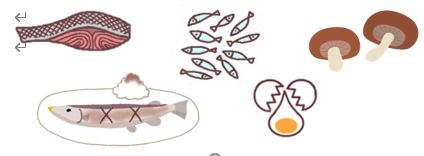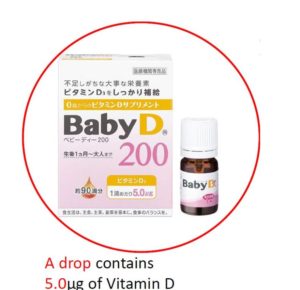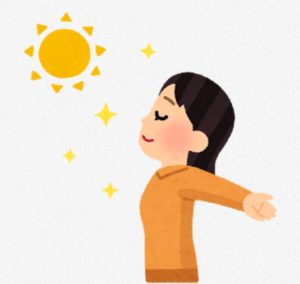
27 Jul People Can Easily Develop Vitamin D Deficiency
Vitamin D deficiency
Because Hokkaido is in the north, the intensity of sunlight is relatively weak during winter. When the intensity of sunlight in Tokyo is, just say, 1, the intensity in Sapporo is only about 1/3 of that. Many people are afraid of skin cancer caused by the ultra-violet (UV) rays. Therefore, many people try to avoid direct sunlight and some even go as far as applying sunscreen creams all over their skin to block the UV rays. There are people who prefer working and/or playing indoors rather than outdoors. All these factors contribute to vitamin D deficiency.
Fish such as bonito, salmon, trout, Pacific saury, mackerel as well as mushrooms are relatively rich in vitamin D, however the amount of vitamin D that can be absorbed naturally from food is very low. For breastfeeding babies, it is even harder to get sufficient vitamin D orally, because a mother’s milk contains very little vitamin D and because babies only eat a limited amount of vitamin D-rich foods.
What diseases are caused by vitamin D deficiency?
A lack of vitamin D may cause rickets and osteomalacia (bone softening) in children and can cause osteoporosis in adults. Children may experience difficulty walking due to bone pain and bone deformities in their legs and feet. For adults, their backbones can be fractured by pressure which makes it difficult to stand upright. Vitamin D helps prevent not only bone-related problems but also diabetes mellitus, high-blood pressure and cancers.
Who needs more vitamin D?
People living in high latitude regions have low levels of vitamin D stored in their skin due to the weak sunlight. Lactating mothers require more vitamin D. Likewise, infants and children need relatively a large amount of vitamin D for their physical growth, but oral intake rarely meets their demands. For elderly people, the production of vitamin D in their skin, the intestinal absorption of vitamin D and the activation of vitamin D in the liver as well as kidney are very poor.
Vitamin D deficiency reported in North America is often found more among the population with African ancestry. The melanin pigmentation weakens the effect of sunlight to the skin which reduces the vitamin D production in the skin. Eating and lifestyle habits can increase the risk of vitamin D deficiency.
Daily dosage of vitamin D
The recommended daily amount of vitamin D is 400 international units (IU) for children up to age 12 months, 600 IU for age 1 to 70, 800 IU for people over 70 years of age.
Vitamin D in natural food
Bonito “Katsuo” 鰹 : 400IU/100g,
Dried Bonito “Katsuo-Bushi” 鰹節 :430IU/100g,
Salmon ”Sake” 鮭 and Trout “Masu” 鱒 :200IU/100g,
Pacific Saury ”Sanma” サンマ :340IU/100g,
Mackerel ”Saba” 鯖 :300IU/100g,
Yellow tail ”Buri” 鰤 :360IU/100g,
Cultivated young yellow tail “Hamachi” ハマチ :20IU/100g,
Dry anchovy fry “Shirasu” シラス :200IU/100g,
Flat fish ”Karei” カレイ :60IU/100g ,
Cod ”Tara” 鱈, Herring “Nishin”鰊, Tuna “Maguro” 鮪: 30, 40, 20IU/100g respectively,
Egg yolk 卵黄 :160IU/100g ,
Cow giblets ”Gyu-motsu” 牛モツ (hearts and kidneys ):10-30IU/100g,
Pork liver 豚の肝臓:110IU/100g,
Fresh shiitake mushroom “ Shiitake”シイタケ(生):90IU/100g ,

How to supplement vitamin D?
In order to compensate for a lack of sunlight exposure with enough Vitamin D from food to meet the adequate levels, you would have to eat an excessive amount of fish. If you think about the necessary intake, supplementing it from mushrooms would be very limited. The American Academy of Pediatrics (AAP) recommends vitamin D supplementation. When your babies are fed with breast milk only, their daily vitamin D intake hardly meets the recommended daily requirements of 400IU/day. The amount of vitamin D contained in breast milk depends on the mothers’ vitamin D storage capacity and varies from 0.6 to 3.0 µg (36 -200IU)
Vitamin D supplement
By applying vitamin D syrup on your nipples and/or your fingertips, your baby can suck them to easily meet their daily intake. Bottled vitamin D syrups from the USA typically contain 400 IU, while Japanese products contain 80 IU or 200 IU. In Japan, we recommend a supplement with 200IU concentration of vitamin D called “BabyD®200”.
Please ask your baby’s pediatrician for this supplement at his/her one-month health check-up.
Worries about vitamin D overdose
You should worry about overdosing, if you have given more than 1000IU/day to infants who are 0-6 months, 1500IU/day to 7-12 months, and 2500 IU/day to 1-3 years old.
Due to the low dose of vitamin D supplements in Japan (80 or 200 IU/drop) you do not need to worry about giving your baby too much (less than 1000 IU/day). But please be mindful of the strength of the supplement you are using (US strength: 400 IU/drop).
- Even if you have a healthy normal diet, your vitamin D level will usually not meet the daily requirement.
- While living in Hokkaido, try to eat food rich in vitamin D.
- Take more vitamin D while you are breast-feeding.
- Expose your skin to the sun but not to the point that would irritate your skin.
- Babies need sufficient sun exposure, especially in winter.
- Take vitamin D supplement if you are worried about vitamin D deficiency.


Nobuko Kawamata M.D.


